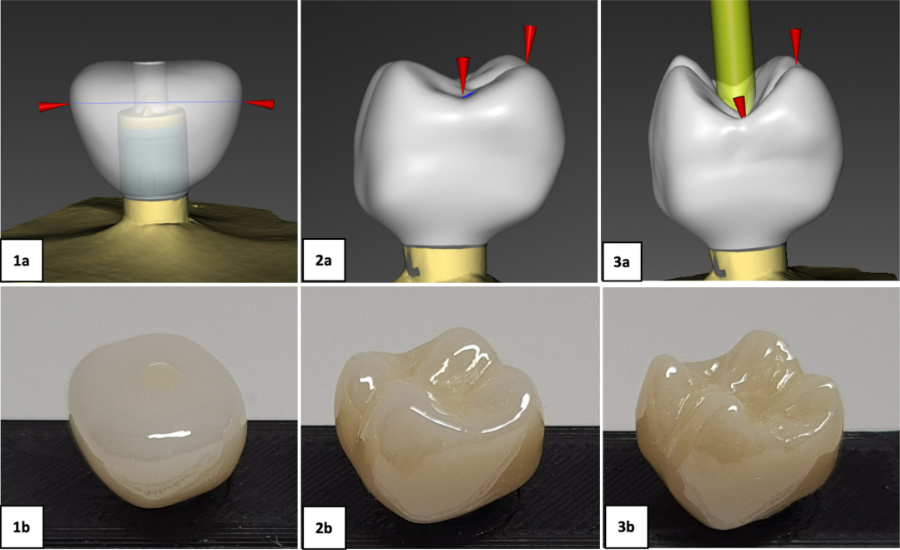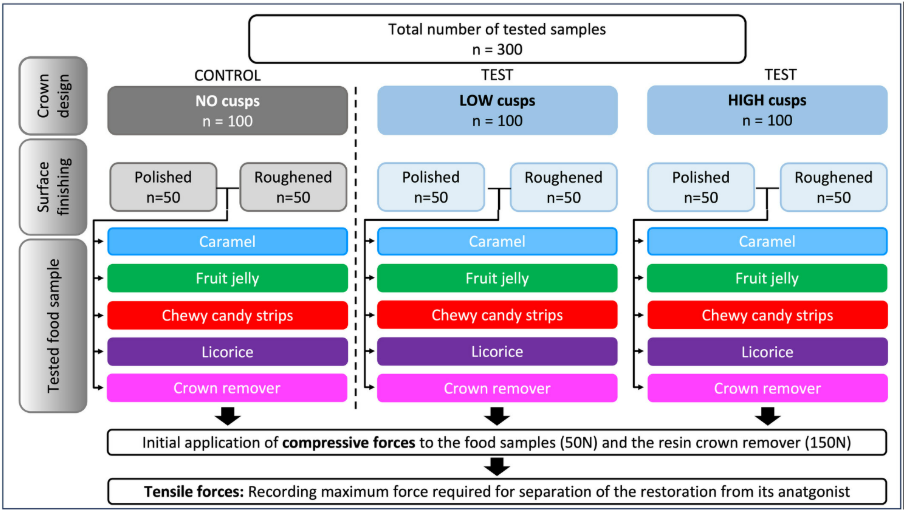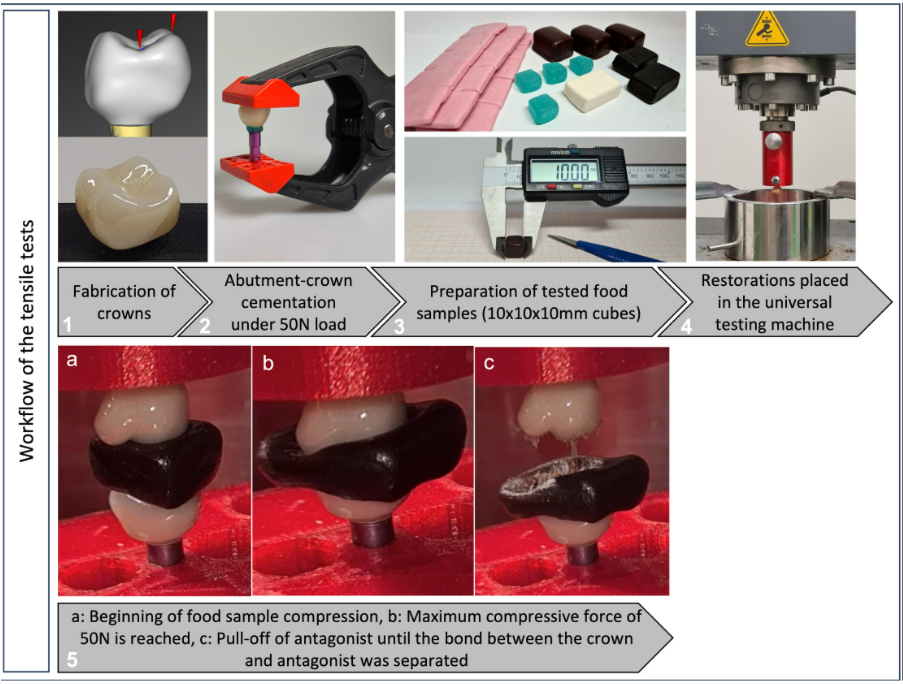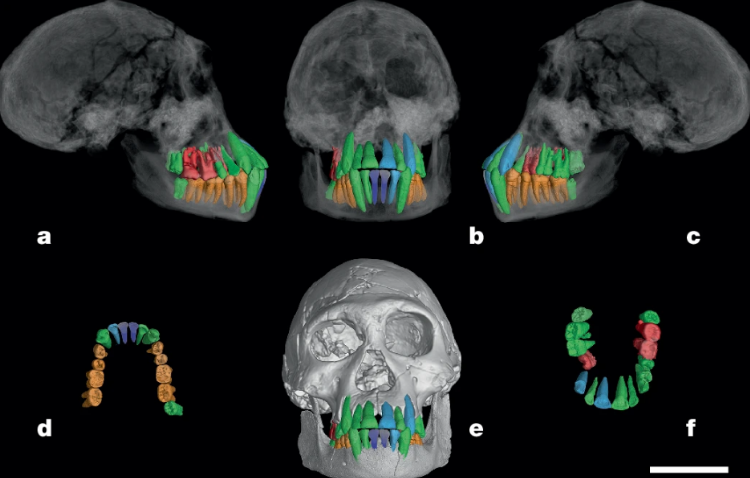Pull-Off Forces on Implant-Supported Single Restorations by Sticky Food: An In Vitro Study
Dental implants are now a standard treatment option to replace missing teeth. This type of restoration provides excellent aesthetics and effectively restores chewing function. Implant-supported restorations can be retained using either screws or cement. Both methods offer good reliability, but screw retention is more commonly used for multiple-unit restorations, while cement retention is frequently employed for single-tooth replacements.
This leads to a clinical challenge: stronger cement retention reduces the risk of crown detachment but makes non-destructive removal of the crown difficult. Temporary cements provide less retention force, allowing for easier removal of the prosthesis without damage. However, this increases the risk of de-cementation, potentially leading to crown failure, especially when challenged by sticky foods.
Therefore, we want to share the results of a recent in vitro study published in Clinical Oral Implants Research, which investigated the pull-off forces exerted by sticky foods on crowns and whether these forces can lead to failure of implant-supported crowns.
Study design and methodology
Objective of the study
The main objective of the study was to determine the cement retention force needed to prevent crown failure caused by sticky foods.
Materials and methods
Test samples
Implants and abutments: Standard titanium abutments were used, secured to 4.3 mm diameter implant analogs. The implant analogs were then fixed within a specialized testing machine.
Crowns: A total of 300 zirconia crowns were fabricated using CAD/CAM technology. To simulate the variability seen in natural teeth, crowns with different cusp and fissure morphology were manufactured:
- NC (No Cusps): Control group, crowns without any cusps.
- FC (Flat Cusps): Crowns with flattened cusps.
- HC (High Cusps): Crowns with prominent, high cusps.

CAD/CAM designing and fabrication of the three different crown designs tested in the study. (1a, 2a, and 3a) Represent the designed crowns with no cusps, low and high cusps, respectively. (1b, 2b, and 3b) Represent the milled and polished crowns with no cusps, flat and high cusps, respectively. Clinical Oral Implants Research/ Shaza Bishti/ 14355/ 2024
Additionally, the crowns were categorized based on surface roughness:
- r (Rough) – rough
- s (Smooth) – smooth
Each of these groups contained 10 crowns. Screw-retained crowns using hybrid abutments were also included (monolithic designs which do not use cement). This was done to isolate the effect of cement failure and exclude other factors that could influence the measurement results.

A graph illustrating the different control and test groups investigated in the study. The tested samples were divided according to their crown design, surface roughness and type of food (n = 10/group). Clinical Oral Implants Research/ Shaza Bishti/ 14355/ 2024
Bonding of crowns
A self-curing luting composite (Multilink Hybrid Abutment H0, Ivoclar Vivadent, Schaan, Liechtenstein) was used for bonding. A universal primer (Monobond Plus, Ivoclar Vivadent, Schaan, Liechtenstein) was applied to the abutments and the inner surface of the crowns for 60 seconds. The luting composite was mixed according to the manufacturer’s instructions and evenly applied to the inner surface of the crowns. The crowns were immediately seated using finger pressure and then held in place under a 50 N load using a clamp (TOOLCRAFT, Conrad Electronic SE, Hirschau) for 10 minutes. After initial setting, excess luting composite was removed.
Types of sticky food
Four types of sticky food were used:
- Caramel
- Fruit jelly
- Chewy candy strips
- Licorice
A specialized resin used for crown removal was also tested. All substances were heated to 36.4°C before use.
Test equipment
A universal testing machine was used. All crown samples were secured in a setup that simulated human chewing movements. The testing machine recorded the force at which the crowns detached due to the adhesive force of the sticky food.
Testing procedure
Prepared sticky substances were placed between the crowns and compressed with a force of 50 N for the food samples and 150 N for the resin (crown remover). The maximum pull-off force (in Newtons [N]) was then recorded. The 50 N force was chosen to compress the selected food samples without causing complete compression or cutting through the food. Three-way analysis of variance (ANOVA) was used for statistical analysis.
A displacement-force diagram was plotted, and the maximum force required for separation was recorded in Newtons. After each test, the restorations were cleaned to remove any food residue from the surface to avoid influencing subsequent tests. The surfaces were degreased with 70% ethanol after cleaning. Each food sample was used only once, and each test was repeated 10 times.

Workflow of the tests starting from the designing and fabrication of the crowns, ending with the crown and its antagonist and food sample in the universal testing machine after their complete separation. Clinical Oral Implants Research/ Shaza Bishti/ 14355/ 2024
Research results
The highest average pull-off force was recorded for caramel in combination with high cusps (HC) and a rough surface (r) – (12.09 ± 1.26 N). The lowest was for licorice in combination with flat cusps (FC) and a smooth surface (s) – (3.21 ± 0.15 N). For the resin (crown remover), the breaking force on crowns with high cusps (HC) and a rough surface (r) was, on average, (55.41 ± 3.87 N).
The presence and height of cusps on the crowns, as well as the type of sticky food, significantly affected the pull-off force. Surface roughness (rough or smooth) did not have a statistically significant effect on the results.
Conclusions and Conclusions
In summary, the cement bond needs a retention force of at least 20 N to reliably exceed the pull-off force of any of the sticky foods tested. However, the retention force of the crown should not exceed 60 N to allow for safe removal of the denture with crown removal resin. Even with these figures, choosing the appropriate cement remains a challenge.
Cements are often classified as:
- temporary
- permanent
- semi-permanent
Based on current understanding, semi-permanent cements appear to meet the necessary requirements. These cements are defined as providing adequate retention under masticatory forces while also allowing for prosthesis removal without damaging the implant restoration. These cements have been reported to have a retention force ranging from 50 to 200 N. This wide range in retention force is because bond strength depends not only on the cement itself but also on the height, diameter, and shape of the abutment, which influence the contact area between the crown and the abutment. However, it is not always possible to safely remove a crown with a retention force of 200 N, especially because this force exceeds the breaking force of the crown removal resin. Therefore, the search for cement formulations with optimal retention strength continues.
Let’s examine the properties of the other cement classifications more closely:
- Most temporary cements reported in the literature exhibit average retention forces ranging from 4.52 to 17.82 N after thermal cycling. These forces are not only lower than the resin-based pull-off forces but also lower than the pull-off forces produced by caramel in this study.
- Permanent cements have very high retention strength and are designed for long-term retention. Current studies report retention forces ranging from 72.01 N to 211.25 N. These values are much higher than those produced by sticky foods and even higher than the adhesion force of crown removal resins. Consequently, restorations cemented with permanent cements are very difficult to remove non-destructively.
The development of new types of semi-permanent cements with more predictable retention strengths is a promising area of research.
Many clinicians have identified cement types that meet their needs empirically. However, new studies that test the retention forces of cements from different manufacturers would be beneficial. These studies should also consider the shape, diameter, height, and taper of the abutments, as well as other factors that influence bond strength. This will facilitate the development of new prosthetic retention protocols with predictable retention forces.
That’s all for now, stay tuned for next publications.








